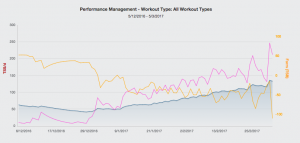A couple of days ago I was lucky enough to spend the morning with Stephen ‘Oossh‘ Buckley, the Strength and Conditioning Coach for the NZ Breakers Basketball team. He mentioned that he believes Performance equals Fitness minus Fatigue. You can be as fit as you want, but if you are fatigued you will never perform well. Now with Stephen’s players he can’t really quantify this equation but he can subjectively grade it.
As endurance athletes you can utilise the Training Peak’s Performance Management Chart (PMC) to actually quantify the equation. But what does it mean to you.
Fitness
Fitness is built not by singular workouts, but by accumulating a training load over many week of consistent training. Consistency of training is the key to developing and enhancing fitness. How can we measure this build up of fitness? Before I answer that I want to explain about the concept of a Training Stress Score (TSS) and how this TSS can be used to measure how hard a workout is.
Training Stress Score
TSS was developed by Dr Andy Coggan and it rolls both volume and intensity of a session into a single number that represents the total metabolic cost of that workout. The exact equation for TSS is:
TSS = [(s x W x IF) / (FTP x 3,600)] x 100
where:
- s is duration in seconds;
- W is Normalised Power (or Pace for running);
- IF is intensity Factor;
- FTP is Functional Threshold Power; and
- 3,600 is how many seconds are in an hour.
By definition, an hour of riding or running at Threshold pace gets a TSS score of 100, but a ride of 2hrs at a moderate pace could also accumulate a TSS score of 100. Here are some real time examples of what TSS scores for various rides/runs look like:
- 1:20hr ride at Level II = ~60-70
- 40min run at Level II = ~45-55
- 3:30hr ride at Level II = ~170-185
- 2hr run at Level II = ~155-175
- 60min Intervals = ~65-75
A TSS of less than 150 should be easily recovered from and training can continue the next day unencumbered. When the TSS is between 150 and 300 you might find that there is some residual fatigue the next day but you are usually fully recovered by the second day. When it is between 300 and 450 you might find that there is still residual fatigue even after two days. When the TSS is over 450 residual fatigue lasting for several days is likely.
If you add up the TSS for a week you can get an idea of the total training stress for that particular week or microcycle (small block) of training. To make the value for this block of training more meaningful you can average it across the week or microcycle giving you a TSS/day value.
As fitness is the accumulation of training load over many weeks we could average the TSS over a period of many weeks. This is exactly what Training Peaks do with the Chronic Training Load (CTL), which is an average of the TSS over the last 42 days. This is represented on the PMC as a blue line.

In the example displayed by Fig 1, you can see the blue line progressively build towards the NZ Ironman on 5 March 2017.
We can take this TSS and CTL and utilise it to plan a training approach by ramping the CTL up by about 10 per month. If we want to plan a recovery week we can unload the current CTL by about 20 TSS/day. Or if we want to load the athlete up more we could add 30 TSS/day above the current CTL.
So if we go back to Stephen’s equation:
Performance = Fitness – Fatigue
We are now able to quantify the fitness part of the equation. But what about the Fatigue part?
Fatigue
We saw above that the longer the workout or more intense the workout for a given duration the more time it took to recover from, but how much fatigue accumulates in the body. Can we quantify it?
As part of the PMC the pink line represents the Acute Training Load (ATL) or how much training has been done recently, in the last 7 days. So this is the short term build up of training load and represents fatigue. It is quantified by averaging the daily TSS from the previous 7 days.
Obviously the ATL is only a representative of the training load and doesn’t include other life stresses that leave the body fatigued (such as relationship, financial, work stresses etc…) but it is a very good representation of the training stress on the body.

In Fig 1 above you can see the pink line spiking each time the athlete does a big workout or big block of training. As the overall CTL (fitness) builds up so too does the ATL (fatigue). This needs to come down prior to their event.
Form
The difference between the build up of fitness and accumulation of fatigue is what Training Peaks refer to as Training Stress Balance (TSB) or ‘Form‘ and this is represented as the yellow line. When we return to Stephen’s equation:
Performance = Fitness – Fatigue
we can see that Performance and what Training Peaks call Form are effectively one and the same thing.
This is all well and good, unfortunately it doesn’t help Stephen with managing the workload of the NZ Breakers basketball team, although they are starting to utilise GPS data about how they move around the court during both games and trainings (I’m sure there is some way this can be modified for team sport athletes).
The good news is if you are an endurance athlete training with some combination of Power (for cycling or running), Pace (for running or swimming) or Heart Rate (for cycling or running) a reasonably valid TSS can be developed and you can monitor your Performance Management Chart to see how your Form or Performance is tracking.
If you would like further advice feel free to contact me.
I am the Head Coach & Director of Qwik Kiwi Coaching.
I specialise in assisting first timers and recreational athletes to achieve their sporting goals. I can be contacted at coachray@coachray.nz and 021 348 729.
Join over 2,391 people who have already signed up to be kept up to date with great workouts and training information in my informative newsletter.

One Reply to “Performance = Fitness – Fatigue”